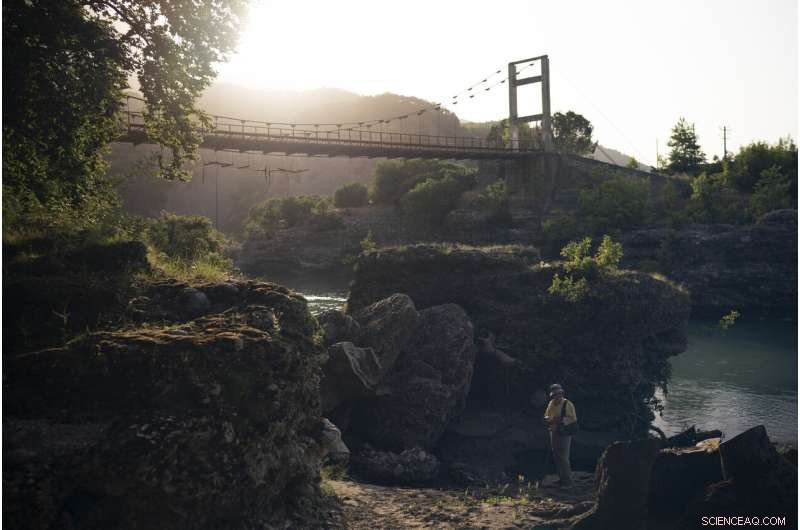
En este 14 de junio Foto 2019, Jorgji Ilia, 71, se encuentra en la orilla del río Vjosa después de recolectar agua de un pequeño manantial en el pueblo de Kanikol, Albania. "No hay nada mejor que el río, "dice el maestro jubilado." La Vjosa le da belleza a nuestro pueblo ". (Foto AP / Felipe Dana)
Bajo un amplio plátano cerca de la frontera de Albania con Grecia, Jorgji Ilia llena un matraz maltratado de uno de los muchos manantiales del río Vjosa.
"No hay nada mejor que el río, "dice el maestro jubilado." La Vjosa le da belleza a nuestro pueblo ".
El Vjosa es temperamental y voluble, cambiando de azul cobalto translúcido a marrón lodo a verde esmeralda, de un flujo constante a un torrente furioso. Nada lo detiene durante más de 270 kilómetros (170 millas) en su curso a través de las laderas cubiertas de bosques de las montañas Pindus de Grecia hasta la costa adriática de Albania.
Este es uno de los últimos ríos salvajes de Europa. ¿Pero por cuánto tiempo?
El gobierno de Albania ha puesto en marcha planes para represar el Vjosa y sus afluentes para generar la electricidad que tanto necesita uno de los países más pobres de Europa. con la intención de construir ocho presas a lo largo del río principal.
Es parte de un auge mundial de la energía hidroeléctrica, principalmente en el sudeste asiático, Sudamerica, África y partes menos desarrolladas de Europa. Solo en los Balcanes, sobre 2, 800 proyectos para domesticar ríos están en marcha o planeados:un "tsunami de represa, "dice Olsi Nika de EcoAlbania, una organización sin fines de lucro que se opone a los proyectos.
Algunos promocionan la energía hidroeléctrica como un fuente de energía barata y renovable que ayuda a frenar la dependencia de los combustibles fósiles que calientan el planeta como el carbón, petróleo y gas natural. El Panel Intergubernamental sobre Cambio Climático dice que tiene un "potencial significativo" para reducir aún más las emisiones de carbono.
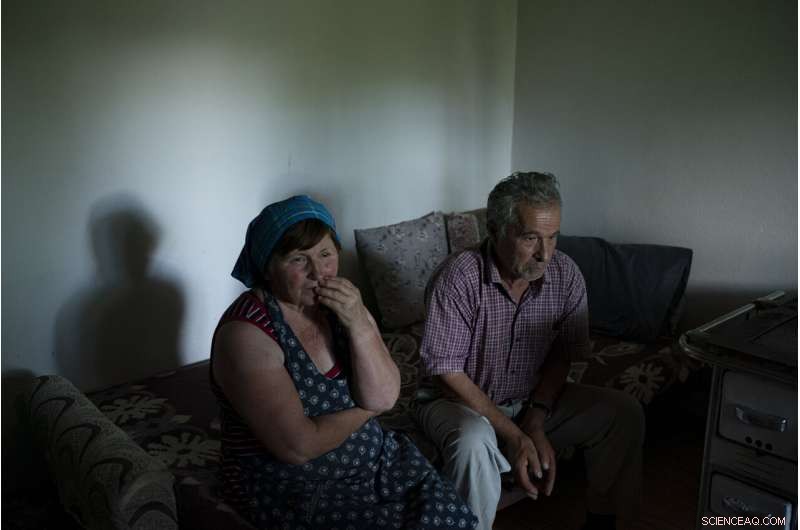
En este 19 de junio, Foto 2019, Jorgji Ilia, 71, un maestro de escuela jubilado, se sienta con su esposa, Vito, 64, dentro de su casa en el pueblo de Kanikol, Albania. "No hay nada mejor que el río, ", dice." La Vjosa le da belleza a nuestro pueblo ". (Foto AP / Felipe Dana)
Pero algunos estudios recientes cuestionan el valor de la energía hidroeléctrica en la lucha contra el calentamiento global. Críticos como EcoAlbania dicen que los beneficios de la energía hidroeléctrica son exagerados y compensados por el daño que pueden causar las represas.
Los ríos son una parte crucial del ciclo global del agua. Actúan como arterias de la naturaleza, llevando energía y nutrientes a través de vastos paisajes, proporcionar agua para beber, producción e industria alimentaria. Son un medio de transporte de personas y mercancías, y un refugio para navegantes y pescadores. Los ríos albergan una diversidad de peces, incluidos pequeños pececillos, truchas y salmones, y proporcionan refugio y alimento a aves y mamíferos.
Pero las presas interrumpen su flujo, y la vida dentro y alrededor de ellos. Si bien la instalación de escaleras para peces y la ampliación de túneles para evitar las presas ayuda a algunas especies, no ha funcionado en lugares como el Amazonas, dice Julian Olden, un ecologista de la Universidad de Washington que ha estudiado los impactos de las represas en Brasil, Australia y EE. UU.
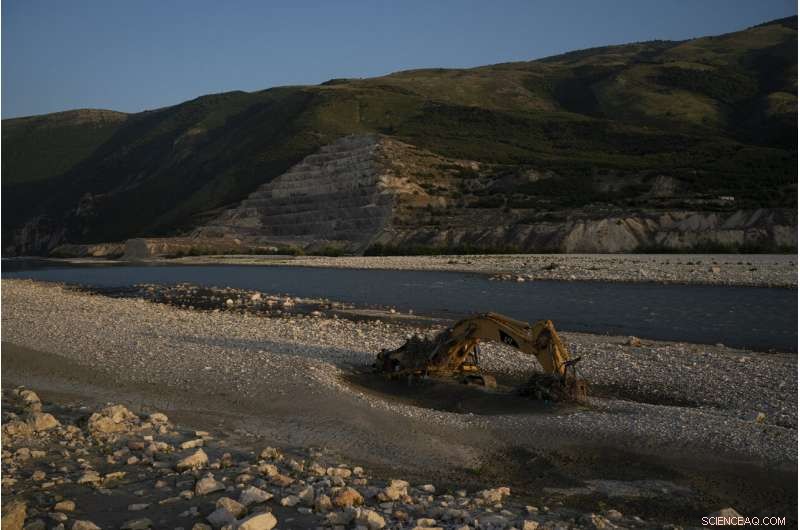
En este 23 de junio Foto 2019, una excavadora abandonada se encuentra a orillas del río Vjosa en el sitio de construcción de la presa Kalivac en Albania. Algunos promocionan la energía hidroeléctrica como un fuente de energía barata y renovable que ayuda a frenar la dependencia de los combustibles fósiles que calientan el planeta como el carbón, petróleo y gas natural. Pero algunos críticos como EcoAlbania dicen que los beneficios de la energía hidroeléctrica son exagerados y compensados por el daño que pueden causar las represas. (Foto AP / Felipe Dana)
Las presas bloquean el flujo natural de agua y sedimentos, y puede causar cambios de temperatura dañinos. También pueden cambiar la química del agua y hacer que crezcan algas tóxicas.
"Una vez que las presas entran, casi no hay vuelta atrás "Olden dice." Matas de hambre a un río de agua. No es de extrañar que sus habitantes probablemente desaparezcan ".
Aquellos que viven a lo largo de la orilla del río o dependen de la vía fluvial para su sustento temen que las represas puedan matar a los Vjosa como los conocen. Su frágil ecosistema se verá alterado irreversiblemente, y muchos residentes perderán sus tierras y hogares.
"Es como los humanos, "dice Elton Pashollari, un guía de rafting cuyos clientes se sienten cada vez más atraídos por la naturaleza salvaje de Vjosa. "¿Qué pasa si una de sus arterias, para, la sangre ya no circula? Es lo mismo con el Vjosa ".
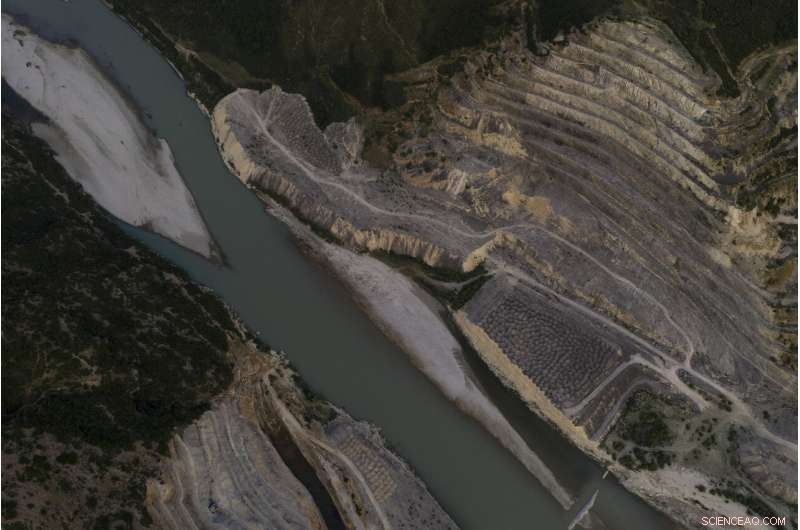
Este 23 de junio La foto aérea de 2019 muestra el sitio de construcción de la presa Kalivac a orillas del río Vjosa en Albania. A medida que se intensifica la presión para construir represas en los países menos desarrollados, sucede lo contrario en EE. UU. y Europa occidental, donde hay un movimiento para derribar presas consideradas obsoletas y destructivas para el medio ambiente. (Foto AP / Felipe Dana)
___
Del plátano de Ilia cerca de la frontera griega, el Vjosa fluye hacia el norte a través de estrechas gargantas antes de pasar por la ciudad de Tepelene, cada vez más lánguido y ensanchándose en anchos bancos de grava, su flujo se divide en hebras, lo que los científicos llaman un río trenzado.
Esta característica es típica de los ríos salvajes y es fundamental para el ecosistema local. Crea diversos hábitats y permite que los sedimentos fluyan, fertilizando las llanuras aluviales y rejuveneciendo el cauce del río.
Es aquí donde el Vjosa revela otro lado de su naturaleza salvaje. Después de las inundaciones estacionales, el río puede cambiar de rumbo, sus trenzas se vuelven a formar a lo largo de la grava profunda que sirve como filtro y sistema de autopurificación. Salta de izquierda a derecha hacia el centro, en un área de alrededor de 1,5 kilómetros (1 milla) de ancho.
"Un río natural es un río dinámico ... un río vivo, " says Nika of EcoAlbania. "It's living day by day and it changes its face. After each flood, you could never see the same scenery."
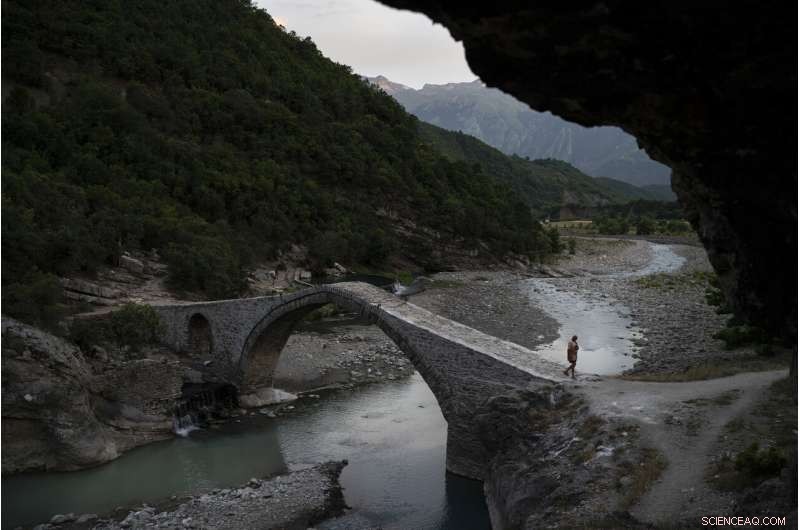
In this June 18, Foto 2019, a man crosses a bridge over the Langarica River, a tributary to the Vjosa near the city of Permet, Albania. Albania's government has set in motion plans to dam the Vjosa and its tributaries to generate much-needed electricity for one of Europe's poorest countries, with the intent to build eight dams along the main river. (AP Photo/Felipe Dana)
The river's ability to clean itself has proved crucial in a country where waste management is often rudimentary. Durante años, people have dumped trash in gullies that washed into the river, leaving trails of plastic and cloth clinging to tree branches. Some towns still dump raw sewage, but the river's self-cleansing means that the overall water quality is passable.
About 25 kilometers (16 miles) northwest of Tepelene, the riverbed narrows into another tight, steep gorge teeming with life, where birds swoop from trees anchored precariously in the cliff-face. Just beyond that comes the first sign of how dramatically a dam would affect the river and the life connected to it.
Emerging from the canyon, it looks like a strip mine. This is Kalivac, one of the proposed dam sites. An Italian company was awarded a contract in the late 1990s. Construction began, but never finished, plagued with delays and financial woes. It now lies derelict with guards stationed to prevent looting.
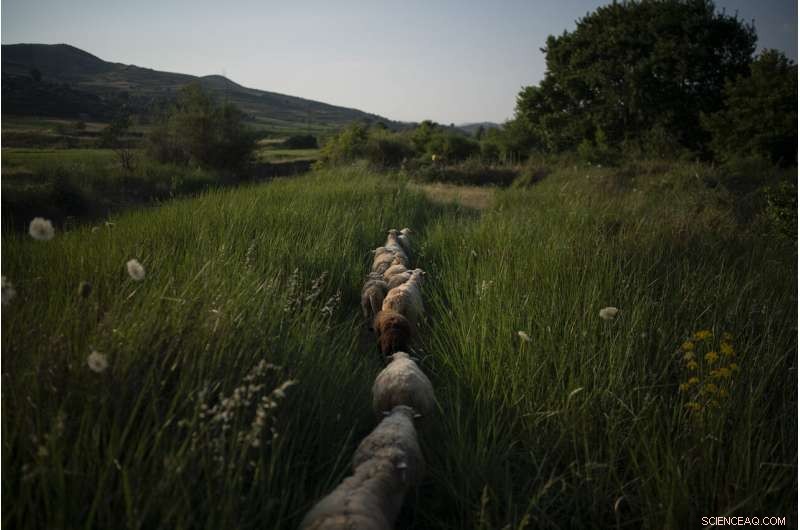
En este 27 de junio, Foto 2019, sheep are pastured near the shore of the Vjosa River in Ane Vjosa, Albania. (AP Photo/Felipe Dana)
Half the hill on one side has been dug away, creating giant steps into the rock. Vehicles sit abandoned, a digging machine sunken into the ground, branches and debris clinging to its frame.
Ahora, the government has awarded a new contract for the site to a Turkish company.
For Benedikt Baeumler, a German advertising executive kayaking the length of the river, the sight was a shock.
"I felt like there's all this wonderful nature, and then suddenly to see these stairs, like the Egyptian pyramids, " él dice.
A few days earlier and several miles upriver, the 43-year-old had been ambivalent about the hydropower projects, noting his own country had also dammed its rivers.
But what he saw at the Kalivac site changed his mind.
"It was really unbelievable what they did to nature, removing entire parts of the mountain, " él dijo, setting up camp on a sandbar back in June. "I hope this dam is never built."

In this June 28, Foto 2019, Shyqyri Seiti, pulls his fishing net from the Vjosa River near Ane Vjose, Albania. The 65-year-old boatman has been transporting locals, goods and livestock across the river for about a quarter century. The construction of the Kalivac dam would spell disaster for him. Many of the fields and some of the houses in his nearby village of Ane Vjose would be lost. (AP Photo/Felipe Dana)
Many locals agree. Dozens of residents from the village of Kute, further downriver, joined nonprofits to file what was Albania's first environmental lawsuit against the construction of a dam in the Pocem gorge, a short distance downriver from Kalivac. They won in 2017, but the government has appealed.
The victory, while significant, was just one battle. Una semana después, the government issued the Kalivac contract. EcoAlbania plans to fight that project, también.
Ecologically, there is a lot at stake.
A 2018 study led by University of Vienna's Fritz Schiemer found the Vjosa was incredibly diverse. The team logged more than 90 types of aquatic invertebrates in the places where dams are planned, plus hundreds of fish, amphibian and reptile species, some endangered and others endemic to the Balkans.
But "the majority of the specific biodiversity will disappear in the case of the planned dam constructions, " they warned.
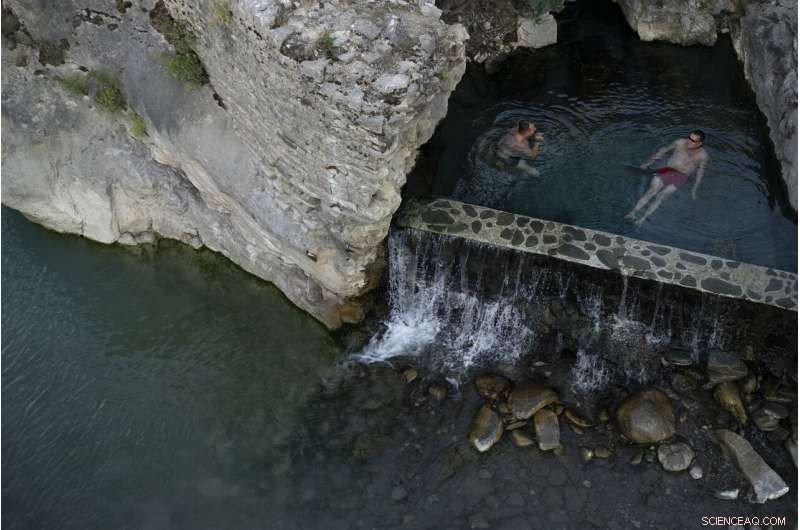
En este 20 de junio Foto 2019, people bathe in a thermal spring on the banks of the Langarica River, a tributary to the Vjosa near Permet, Albania. (AP Photo/Felipe Dana)
Dams can unravel food chains by reducing populations of insects that feed fish and by limiting spawning, which in turn leaves less prey for fish-eating birds and mammals. But the most well-known problem with building dams is that they block the paths of fish trying to migrate upstream to spawn. The U.S. Atlantic salmon population has plummeted, según la Administración Nacional Oceánica y Atmosférica, in great part due to dams.
As pressure to build dams intensifies in less developed countries, the opposite is happening in the U.S. and western Europe, where there's a movement to tear down dams considered obsolete and environmentally destructive.
Más de 1, 600 have been dismantled in the U.S., most within the past 30 years, according to the advocacy group American Rivers. En Europa, the largest-ever removal began this year in France, where two dams are being torn down on Normandy's Selune River.
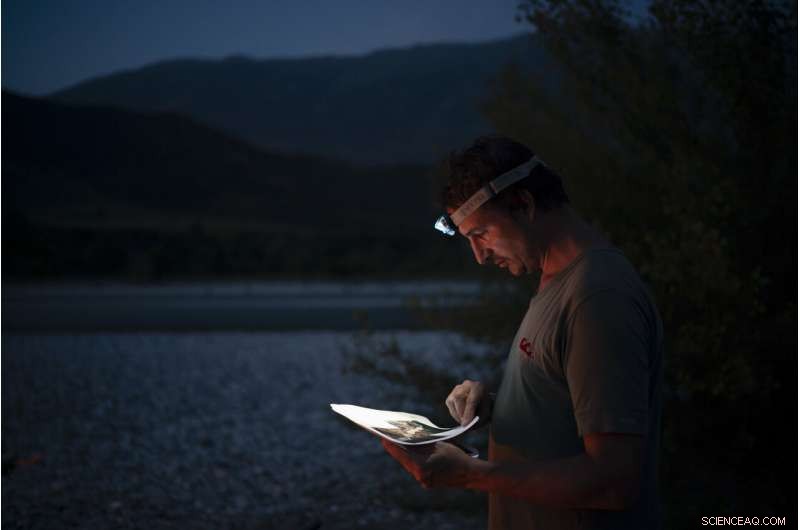
In this June 15, Foto 2019, Benedikt Baeumler, a German advertising executive kayaking the length of the Vjosa River, checks his map after setting up camp on its bank in Albania. A few days earlier and several miles upriver, the 43-year-old had been ambivalent about the hydropower projects, noting his own country had also dammed its rivers. But what he saw at the Kalivac site changed his mind. "It was really unbelievable what they did to nature, removing entire parts of the mountain, " he said. "I hope this dam is never built." (AP Photo/Felipe Dana)
___
With so few wild rivers left around the globe, the Vjosa also is a valuable resource for studying river behavior.
"Science is only at the beginning of understanding how biodiversity in river networks is structured and maintained, " says researcher Gabriel Singer of the Leibniz-Institute in Germany. "The Vjosa is a unique system."
For Shyqyri Seiti, it's much more personal.
The 65-year-old boatman has been transporting locals, goods and livestock across the river for about a quarter century. The construction of the Kalivac dam would spell disaster for him. Many of the fields and some of the houses in his nearby village of Ane Vjose would be lost.
"Para mi, the river is everything, " he says. "Someone will benefit from the construction of the dam, but it will flood everyone in the area. ... What if they were in our place, how would they feel to lose everything?"
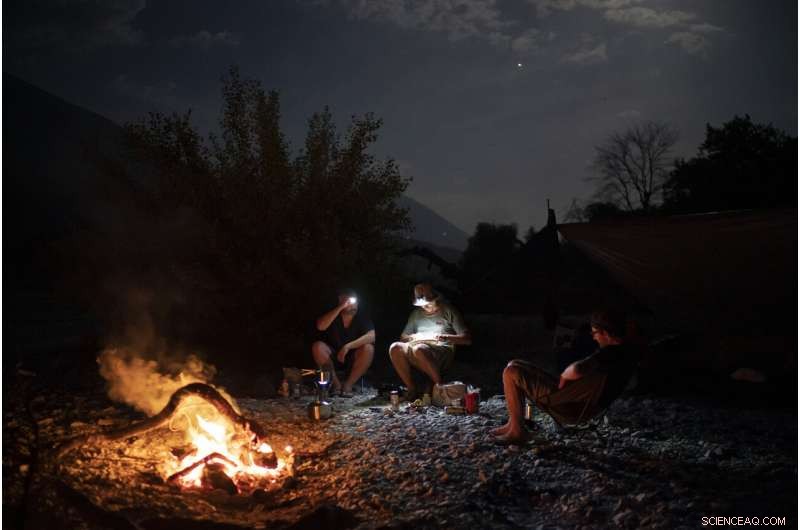
In this June 15, Foto 2019, Jurgen Steinbauer, Benedikt Baumler and Sebastian Baumler, German tourists who are kayaking the length of the Vjosa River, cook a meal as they sit next to a bonfire on the river bank in Albania. After seeing the Kalivac dam construction site, Benedikt Baeumler said, "It was really unbelievable what they did to nature, removing entire parts of the mountain. I hope this dam is never built." (AP Photo/Felipe Dana)
His love for the river runs deep:It feeds his family by providing work and fish to eat and sell. He taught his five children to swim here. Cada mañana, he runs down to the river just to take in the view.
Seiti has protested against the plans, but some of his neighbors disagree. El alcalde, Metat Shehu, insists the community "has no interest" in the matter.
"The Vjosa is polluted. The plants and creatures of Vjosa have vanished, " Shehu says while tending his goats. The biggest issue, él añade, is that villagers are being offered too little to give up their land. He hopes the dam will bring investment to the area.
About 10 kilometers (6 miles) downriver of Ane Vjose lies the village of Kute, on a hill overlooking the Vjosa as it snakes its way north to the sea. Kute residents joined the lawsuit against the Pocem dam that would flood their fields, some houses and, crucially for many, a cemetery. Relieved by their victory, they now wait anxiously for the outcome of the government's appeal.
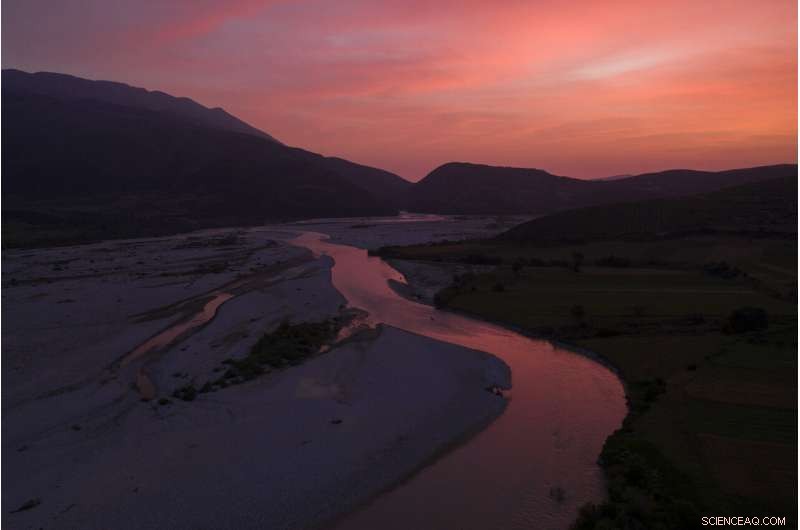
En este domingo June 16, 2019 aerial photo, the sun sets behind the Vjosa River near Tepelene, Albania. Rivers are a crucial part of the global water cycle. They act like nature's arteries, carrying energy and nutrients across vast landscapes, providing water for drinking, food production and industry. (AP Photo/Felipe Dana)
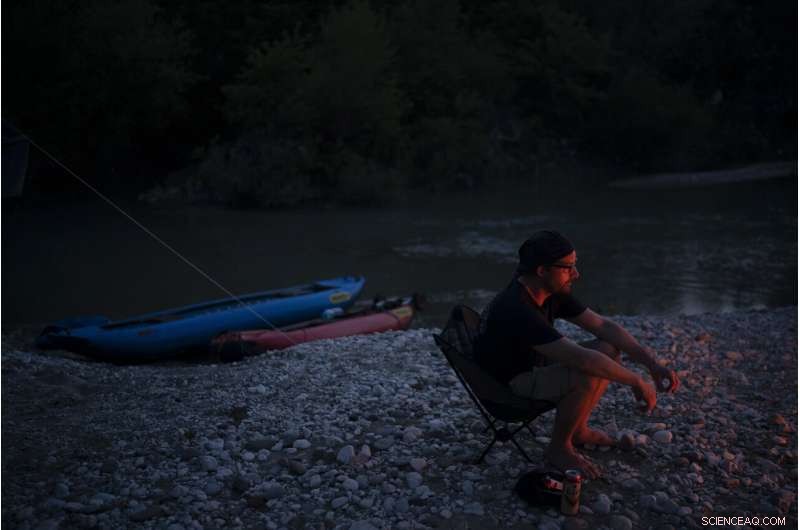
In this June 15, Foto 2019, Sebastian Bäumler, 41, a German filmmaker kayaking the length of the Vjosa River, is illuminated by a bonfire as he sits next to his kayak on its bank in Albania. (AP Photo/Felipe Dana)
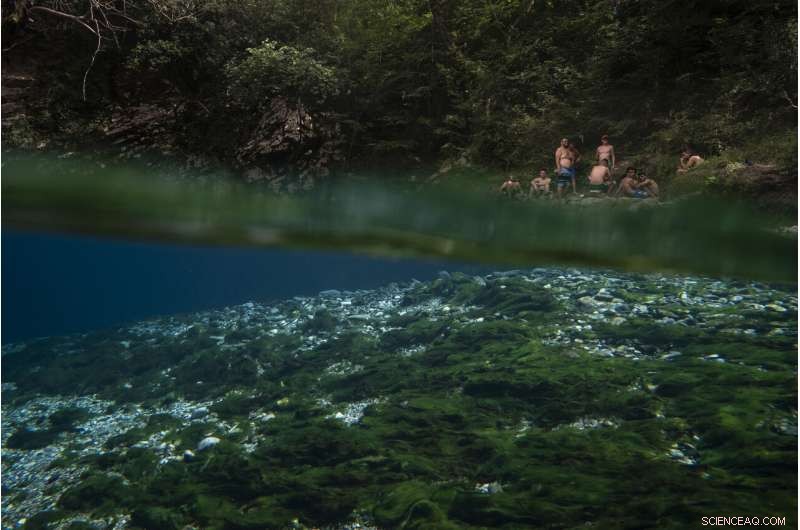
In this June 24, Foto 2019, residents sit on the shore of the Vjosa River next to a spring in the Kelcyre Gorge, Albania. Those who live along the riverbank or rely on the waterway for their livelihood fear dams could kill the Vjosa as they know it. Its fragile ecosystem will be irreversibly altered, and many residents will lose their land and homes. (AP Photo/Felipe Dana)
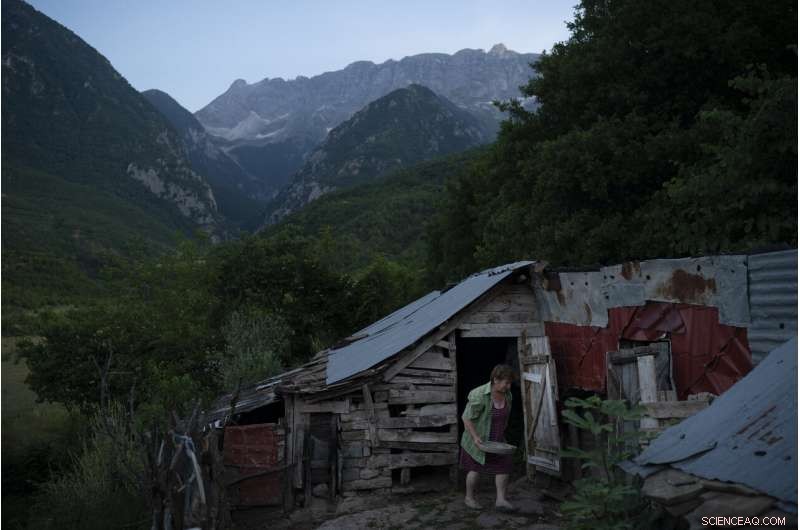
In this June 19, Foto 2019, Vito Ilia, 64, walks out of a small cow shed outside her home in the village of Kanikol, Albania. (AP Photo/Felipe Dana)
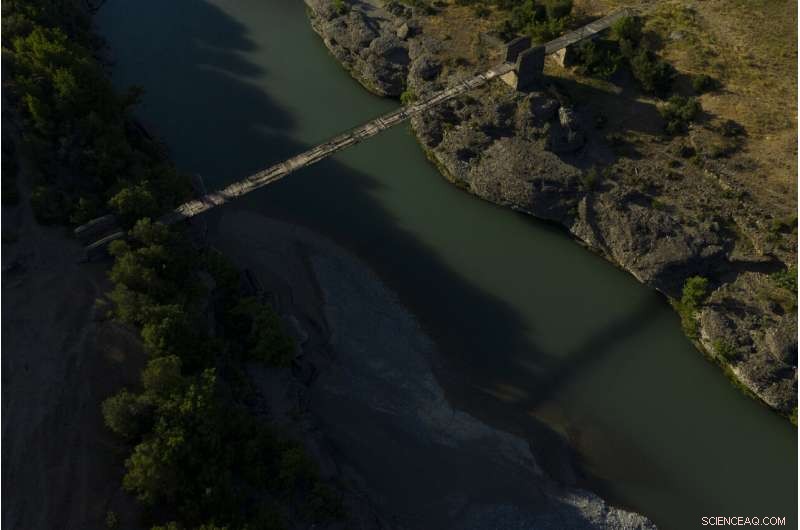
En este 30 de junio Foto 2019, an old bridge spans the Vjosa River near the border with Greece, in Albania. (AP Photo/Felipe Dana)
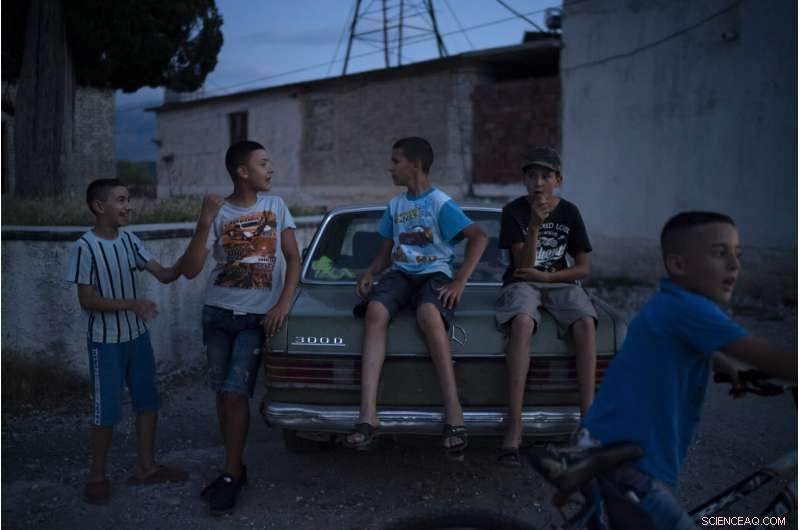
In this June 26, Foto 2019, children play outside at dusk in the village of Kute, Albania. The village overlooks the Vjosa River as it snakes its way north to the sea. Residents here joined a lawsuit against the Pocem dam that would flood their fields, some houses and, crucially for many, a cemetery. (AP Photo/Felipe Dana)
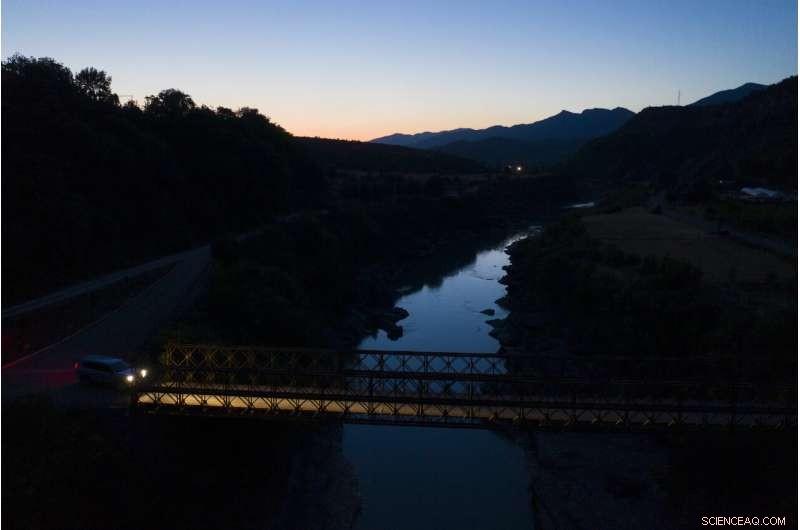
En este 30 de junio Foto 2019, the sky is reflected in the Vjosa River after sunset near the village of Badelonje, Albania. Rivers are a crucial part of the global water cycle. They act like nature's arteries, carrying energy and nutrients across vast landscapes, providing water for drinking, food production and industry. (AP Photo/Felipe Dana)
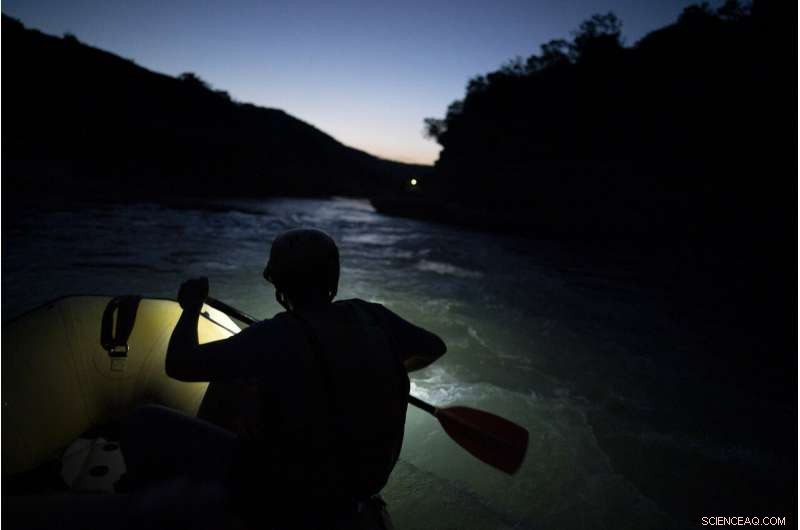
En este 29 de junio Foto 2019, a river rafting guide paddles at dusk on the Vjosa River, Albania. Those who live along the riverbank or rely on the waterway for their livelihood fear dams could kill the Vjosa as they know it. Its fragile ecosystem will be irreversibly altered, and many residents will lose their land and homes. (AP Photo/Felipe Dana)
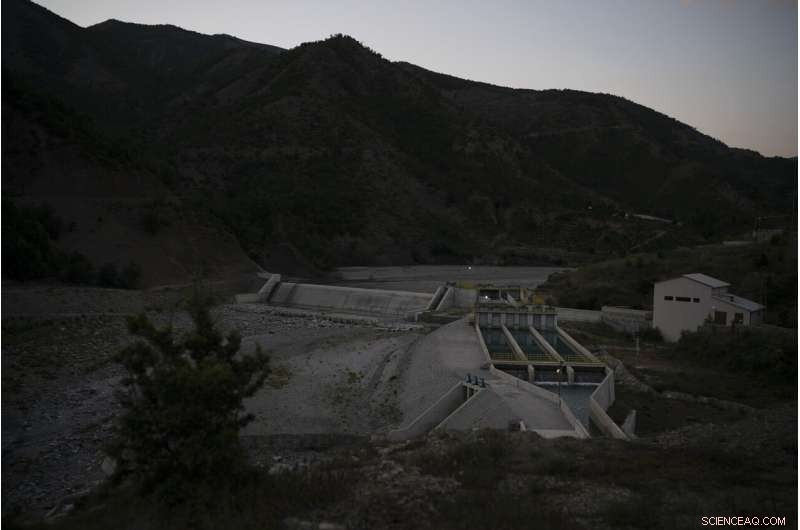
This June 20, 2019 photo shows the Langarica hydropower plant, on a tributary to the Vjosa River near Permet, Albania. As pressure to build dams intensifies in less developed countries, the opposite is happening in the U.S. and western Europe, where there's a movement to tear down dams considered obsolete and environmentally destructive. (AP Photo/Felipe Dana)
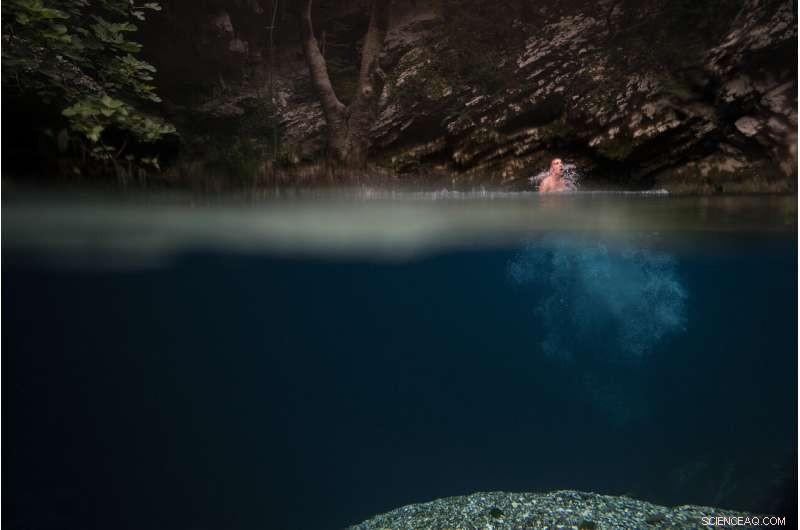
In this June 24, Foto 2019, a man jumps into a spring where it meets the Vjosa River in the Kelcyre Gorge, Albania. Albania's government has set in motion plans to dam the Vjosa and its tributaries to generate much-needed electricity for one of Europe's poorest countries, with the intent to build eight dams along the main river. (AP Photo/Felipe Dana)
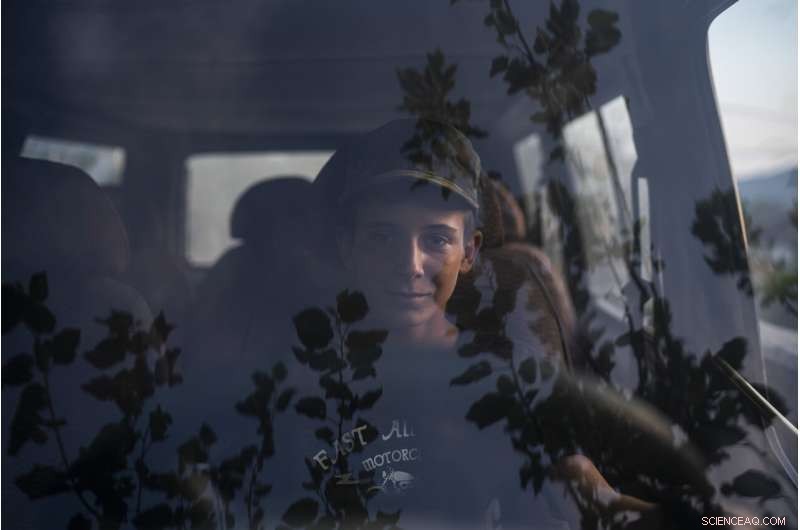
In this June 26, Foto 2019, 13-year-old Eriko, sits in the driver's seat of a car in the village of Kute, Albania. The village overlooks the Vjosa River as it snakes its way north to the sea. Residents here joined a lawsuit against the Pocem dam that would flood their fields, some houses and, crucially for many, a cemetery. (AP Photo/Felipe Dana)
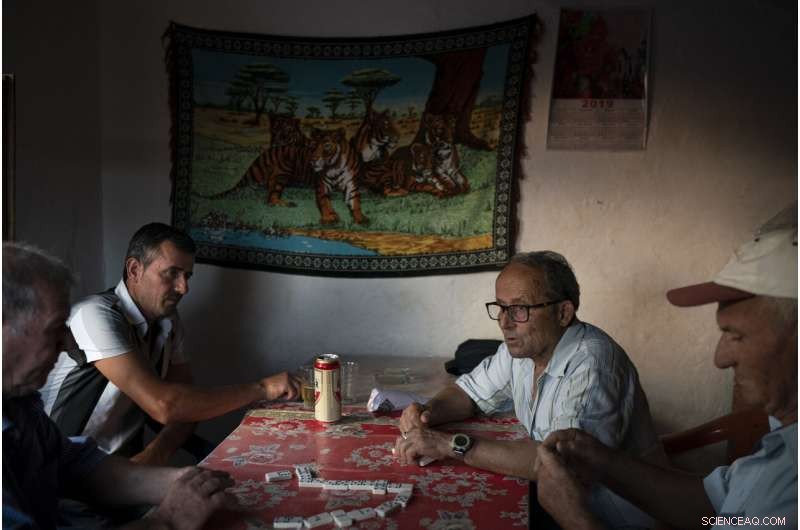
In this June 26, Foto 2019, residents play dominoes in a small bar in the village of Kute, Albania. Dozens of residents from the village joined nonprofit organizations to file what was Albania's first environmental lawsuit against the construction of a dam in the Pocem gorge. They won in 2017, but the government has appealed. (AP Photo/Felipe Dana)
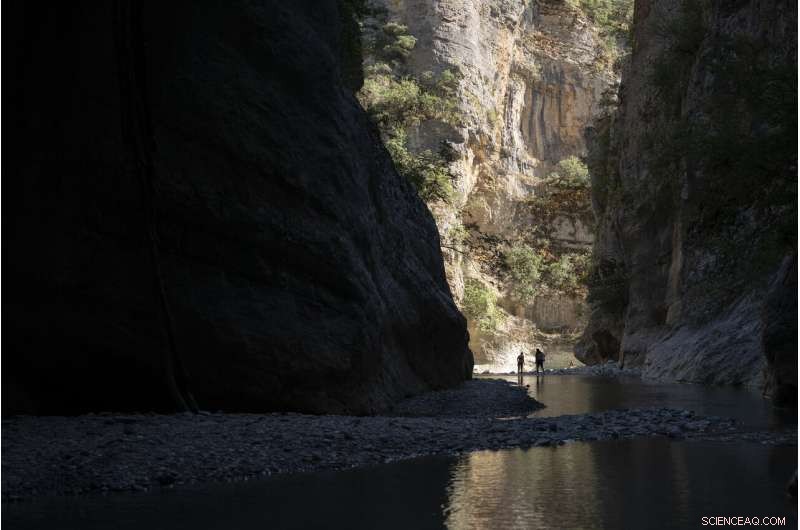
En este 20 de junio Foto 2019, people walk along the Langarica River, a tributary to the Vjosa near Permet, Albania. Albania's government has set in motion plans to dam the Vjosa and its tributaries to generate much-needed electricity for one of Europe's poorest countries, with the intent to build eight dams along the main river. (AP Photo/Felipe Dana)
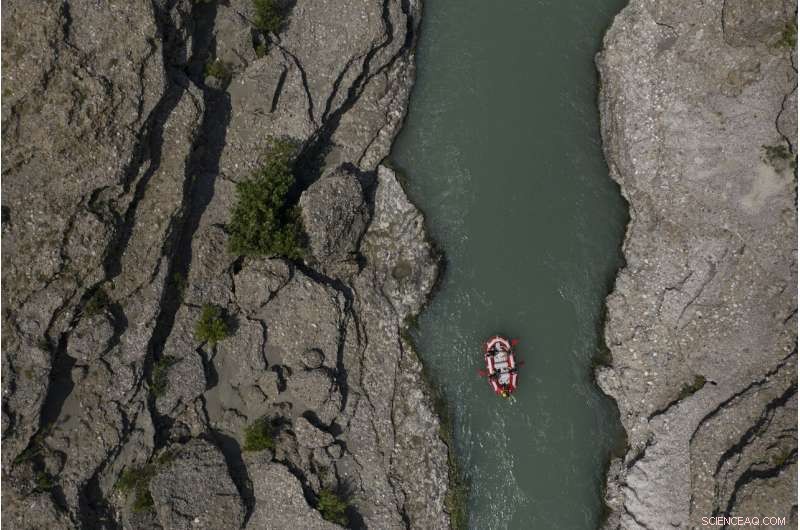
En este 25 de junio Foto 2019, people raft on the Vjosa River near Permet, Albania. Some tout hydropower as a reliable, cheap and renewable energy source that helps curb dependence on planet-warming fossil fuels like coal, petróleo y gas natural. But some critics like EcoAlbania say the benefits of hydropower are overstated—and outweighed by the harm dams can do. (AP Photo/Felipe Dana)
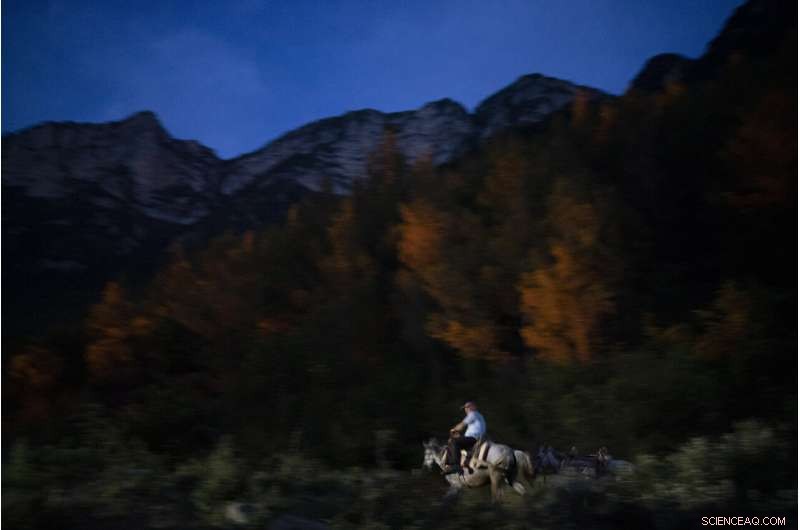
In this June 22, Foto 2019, Jonuz Jonuzi, 70, rides his horse on the banks of the Vjosa River in the Kelcyre Gorge, Albania. He raised his children here and now watches his grandchildren play in the Vjosa's waters. Before dawn each day, he crosses a bridge over a narrow gorge to tend to his goats before his son drives them to drink from a local spring, where the water emerges cold and crystal clear. "Everything I have, I have because of the river, " he says. "Albania needs electrical energy. But not by creating one thing and destroying another. Why do such damage that will be irreparable for life, that future generations will blame us for what we've done?" (AP Photo/Felipe Dana)
There are some signs in their favor. En agosto, the government announced it was canceling a project in central Albania's Holta Canyon near the town of Gramsh, and would tear down part of a dam that's already built. The Infrastructure and Energy Ministry said in a statement the decision came after discussions with residents and an environmental review. Energy ministry officials rejected multiple interview requests to discuss the Vjosa River and the country's hydropower plans.
Could the Vjosa projects also be stopped?
Jonus Jonuzi, a 70-year-old farmer who grew up along the river, still has hope.
He raised his children here and now watches his grandchildren play in its waters. Before dawn each day, he crosses a bridge over a narrow gorge to tend to his goats before his son drives them to drink from a local spring, where the water emerges cold and crystal clear.
"Everything I have, I have because of the river, " he says. "Albania needs electrical energy. But not by creating one thing and destroying another. Why do such damage that will be irreparable for life, that future generations will blame us for what we've done?"
© 2019 The Associated Press. Reservados todos los derechos.